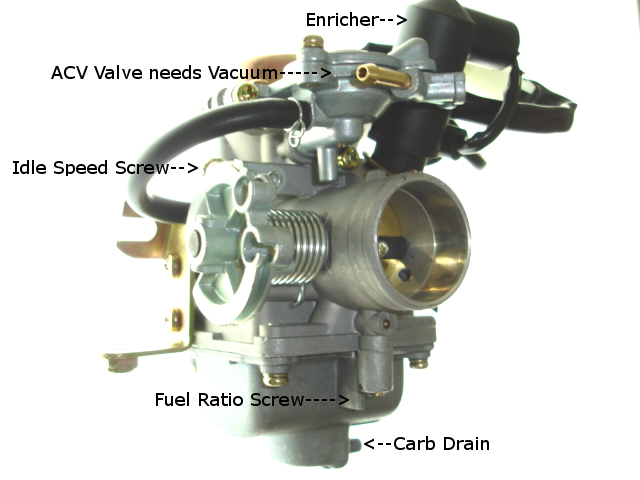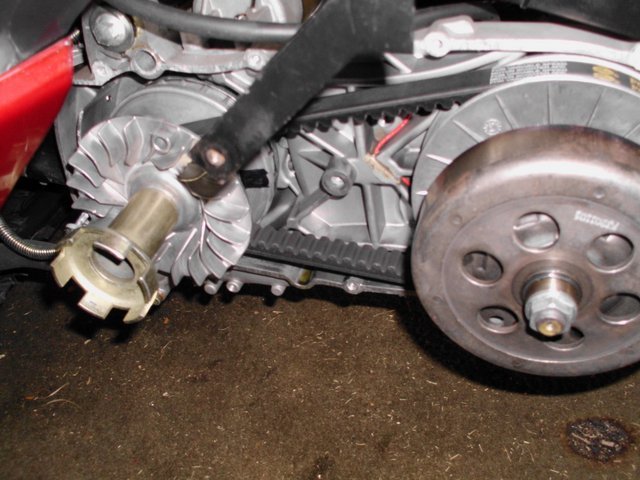|
|
Post by ellpee on Jul 17, 2013 9:54:02 GMT -6
Why can't anything be easy? Went down today to see if I could find the mixture adjust screw and lean things out a bit for our higher altitude. Only screw I found other than those holding on various brackets, etc., is on the bottom of the carb, with maybe 1" of clearance between it and the main engine body. Nothing I have in my tool collection will get in there so I can make the necessary adjustment! And of course it has to be done with the engine running and warmed up, so removing the carb isn't the answer. Sheesh! Guess I'll shop around for some weird tool for awhile, then give up and take it down to a cycle shop and pay them to do it.
MORE: found an inexpensive mini-ratchet screwdriver on Amazon, so that's resolved, but if there's anybody familiar with this horizontal 276-cc engine and its carb, am I even focusing on the correct screw? it's on the bottom side of the carb, more or less directly opposite the enricher that's mounted on the top side, and is completely recessed into the carb body. The flat slot is all that's visible to tell me it's a screw. Does that sound right? If not, where else could it be? As I said, all the other screws I could see are holding on brackets or other components like the enricher or the vacuum chamber cover. (or, of course, there's the idle adjust screw.)
|
|
|
|
Post by rapidjim on Jul 18, 2013 6:53:39 GMT -6
Yes the air fuel mixture screw is on the bottom of the carb.
Jim
|
|
|
|
Post by alleyoop on Jul 18, 2013 11:45:02 GMT -6
You found it and it is a PITA go get at it. Alleyoop  |
|
|
|
Post by ellpee on Jul 18, 2013 18:01:49 GMT -6
Okay, thanks, that tells me I'm on the right track. Hopefully the little offset ratchet screwdriver I ordered will let me do the job. Drizzly day today so I decided to remove the rear fenders and have a go at tightening up the chain. Good thing I did; four large bolts hold the rear axle to the frame, and one of them was completely missing. From the factory? Loosened and fell out? Who knows, but now ALL the bolts associated with the rear axle and the chain-tightening process are good'n'tight and amply coated with Loctite, as are the umpteen bolts that hold the fenders on. Future buyers pay attention to this; I'm sure those axle bolts are way more critical than the fender screws.
BTW Alley, you are truly amazing -- almost always have a picture of whatever is under discussion. I've been looking all over for a good exploded diagram of that carb, no luck so far. You must have the world's biggest picture library.
|
|
|
|
Post by ellpee on Jul 18, 2013 18:11:13 GMT -6
Oh, by the way: pulling the rear fenders reminded me of something really, REALLY dumb about the Magnum. It has a pull starter for emergencies, but IT'S COMPLETELY HIDDEN UNDER THE LEFT REAR FENDER!!! I can just see myself in trouble out on the road somewhere, having to completely remove the rear fenders to use the pull starter. What on earth were they thinking??!!
|
|
|
|
Post by rapidjim on Jul 19, 2013 7:50:31 GMT -6
That motor is also used on 2 wheelers. Just a point, the pull start is useless, I just pretend it isn't there.
Jim
|
|
|
|
Post by ellpee on Jul 19, 2013 10:10:48 GMT -6
The idea actually crossed my mind to see if I could drill a hole through the left rear fender and run the pull rope through that, so I'd have access to the pull handle from above. But on the other hand, I'm hoping I'll never need the pull starter.
|
|
|
|
Post by alleyoop on Jul 19, 2013 21:00:39 GMT -6
The pull starters if used you are asking for trouble in river city. The pull starter engages a piece sticking out that is held on by the Variator NUT AS WELL AS THE FAN PULLEY. Now here is the Beautiful part, When you pull on the ROPE to engage the Piece attached behind the VARIATOR NUT you are turning that piece to turn the crank. But you are pulling and rotating it counter clockwise, and guess what that is the SAME WAY YOU LOOSEN THE VARIATOR NUT. When I first got it I tried it just for the heck of it and found it not easy to use. So I started it with the electric start and went about a half a block and all of a sudden I heard metal to metal in the CVT. STOPPED pulled the cover off and the VARAITOR NUT had come loose when I did the PULLING with the PULL START and ruined my Variator fan fins and had metal shavings inside the cvt. So I just took the thing off and the Piece that sticks out and the PULL START off the CVT cover and now have it open for more air circulation in the cvt and you can see the fan and nut. Alleyoop Here is what I am Talking about:  |
|
|
|
Post by wolfhound on Jul 20, 2013 4:23:15 GMT -6
DX
|
|
|
|
Post by ellpee on Jul 20, 2013 14:05:55 GMT -6
So, as time passes I have learned that my apparently too-rich mixture quickly deposits lots of black stuff on the spark plug, and even what I would consider a minor black buildup on the plug causes it to misfire or not fire at all.
So, went around town today looking for an upscale replacement -- iridium or triple platinum or whatever -- for my OEM NGK plug. Rotsa Ruck, all I could find was the same NGK plug. Okay, fine, bought one and put it in. Scoot fired right up, drove it about 15 miles around town. Ran well, started well for the most part. significant black stuff on plug after only 15 miles. (Yeah, I know, mixture needs adjusting for high altitude, have that scheduled at a local shop next week, my tool collection isn't up to the job.)
What I'm wondering now is, AFTER I have the mixture tweaked, is it really going to be worth my time and trouble to chase around looking for a "foofier" spark plug that the OEM NGK? What's it going to do for me? I'm not looking for burn-rubber performance, just reliability. I know full well this trike isn't ever going to be a "hot" ride.
|
|
|
|
Post by ellpee on Jul 20, 2013 15:29:49 GMT -6
Interesting about that variator nut. On my two-wheel scoot I had the Devil's own time getting that nut loose, wimpy Craftsman impact wrench wasn't up to the job, had to go to a mechanic with a gorilla-grade impact wrench to break it loose the first time. Surprising that the torque from using the hand starter would be enough to cause what you describe. I guess not all scoots, and variators, are created equal.
|
|
|
|
Post by rapidjim on Jul 21, 2013 9:43:41 GMT -6
So, as time passes I have learned that my apparently too-rich mixture quickly deposits lots of black stuff on the spark plug, and even what I would consider a minor black buildup on the plug causes it to misfire or not fire at all. So, went around town today looking for an upscale replacement -- iridium or triple platinum or whatever -- for my OEM NGK plug. Rotsa Ruck, all I could find was the same NGK plug. Okay, fine, bought one and put it in. Scoot fired right up, drove it about 15 miles around town. Ran well, started well for the most part. significant black stuff on plug after only 15 miles. (Yeah, I know, mixture needs adjusting for high altitude, have that scheduled at a local shop next week, my tool collection isn't up to the job.) What I'm wondering now is, AFTER I have the mixture tweaked, is it really going to be worth my time and trouble to chase around looking for a "foofier" spark plug that the OEM NGK? What's it going to do for me? I'm not looking for burn-rubber performance, just reliability. I know full well this trike isn't ever going to be a "hot" ride. The black deposits are from to rich of a mixture caused by the carb. No matter what spark plug you use, until you get your carb issue tended to it will foul. NGK is the only plug I use in my shop. Very realible. Jim |
|
|
|
Post by alleyoop on Jul 21, 2013 10:37:59 GMT -6
Interesting about that variator nut. On my two-wheel scoot I had the Devil's own time getting that nut loose, wimpy Craftsman impact wrench wasn't up to the job, had to go to a mechanic with a gorilla-grade impact wrench to break it loose the first time. Surprising that the torque from using the hand starter would be enough to cause what you describe. I guess not all scoots, and variators, are created equal. Just a warning that is all from REAL LIVE actual experience. Alleyoop |
|
|
|
Post by ellpee on Jul 23, 2013 16:28:53 GMT -6
I recently posted pix for the first time, and now I'm seeing a bunch of crap from photobucket that I HOPE doesn't get posted along with this message. If it does, future posters beware ofr photobucket!!!!!!!!
Took Magnum to a local shop today for carb (mixture) adjustment, SEEMS to be running/idling better but a few hundred miles will tell the true tale.
For general education of others in my situation, though, a bulletin: that idle adjust screw, which was already in a near-inaccessible position underneath the carb in the first place, was "protected" by a metal cap that the guy had to remove, with considerable effort, before he had access to the actual Philips-head mixture screw. I learned something during that process, because to get to it he simply loosened the clamps on the air intake end and the intake manifold end of the carburetor, and rotated the carb to where he could get at the mixture screw. So simple, and never occurred to me!
Anyhow, as I said, it feels like the scoot is now idling better and running smoothly at our relatively high altitudes (6000' plus or minus 2000). Will be pulling and examining the plug at least every 100 miles to see what it looks like.
|
|

